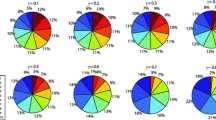Abstract
Consider a two-stage decision making framework under uncertainty, where decisions are made at all times t ∈ T. First, a set of decisions, x, of size |T| is made. Then, one of several possible scenarios, ω ∈ Ω, that represent the uncertainty of the entire spectrum t ∈ T is realized via a parameter \(w_t^\omega \). Second, a new set of decisions based on this particular scenario realization ω, yω, each of which are of size |T|, is made. The first decision, x, is made before knowing the uncertainty. The second decision, y, is made after knowing the specific realization of the uncertainty, ω. Typically, making accurate first-stage decisions that safeguard against a wide variety of scenarios is challenging. The second-stage decisions serve as a recourse to correct or amend the first-stage decisions, however one must pay a price to use this recourse. This is a standard setting for two-stage stochastic programming.
Similar content being viewed by others
References
Ahmed S (2013) Convex relaxations of chance-constrained optimization problems. Optim Lett 8(1):1–12
Ahmed S, Luedtke J, Song Y, Xie W (2016) Nonanticipative duality, relaxations, and formulations for chance-constrained stochastic programs. Math Program 162(1–2):51–81
Ahmed S, Shapiro A (2008) Solving chance-constrained stochastic programs via sampling and integer programming. In: State-of-the-art decision-making tools in the information-intensive age, pp 261–269. INFORMS
Charnes A, Cooper WW (1959) Chance-constrained programming. Manag Sci 6(1):73–79
Günlük O, Pochet Y (2001) Mixing mixed-integer inequalities. Math Program 90(3):429–457
Khachiyan LG (1989) The problem of calculating the volume of a polyhedron is enumerably hard. Russ Math Surv 44(3):199–200
Kleywegt AJ, Shapiro A, de Mello TH (2002) The sample average approximation method for stochastic discrete optimization. SIAM J Optim 12(2): 479–502
Küçükyavuz S (2010) On mixing sets arising in chance-constrained programming. Math Program 132(1–2):31–56
Liu X, Küçükyavuz S, Luedtke J (2014) Decomposition algorithms for two-stage chance-constrained programs. Math Program 157(1):219–243
Luedtke J, Ahmed S (2008) A sample approximation approach for optimization with probabilistic constraints. SIAM J Optim 19(2):674–699
Luedtke J, Ahmed S, Nemhauser G (2010) An integer programming approach for linear programs with probabilistic constraints. Math Program 122(2):410–423
Mak W-K, Morton DP, Wood RK (1999) Monte Carlo bounding techniques for determining solution quality in stochastic programs. Oper Res Lett 24(1–2):47–56
Nemirovski A (2012) On safe tractable approximations of chance constraints. Eur J Oper Res 219(3):707–718
Nemirovski A, Shapiro A (2007) Convex approximations of chance constrained programs. SIAM J Optim 17(4):969–996
Pagnoncelli BK, Ahmed S, Shapiro A (2009) Sample average approximation method for chance constrained programming: theory and applications. J Optim Theory Appl 142(2):399–416
Pflug GC (2000) Some remarks on the value-at-risk and the conditional value-at-risk. Springer, pp 272–2810. https://link.springer.com/chapter/10.1007/978-1-4757-3150-7_15
Prékopa A (2013) Stochastic programming, vol 324. Springer. https://link.springer.com/book/10.1007/978-94-017-3087-7
Rockafellar RT, Uryasev S (2000) Optimization of conditional value-at-risk. J Risk 2(3):21–41
Singh B, Knueven B (2021) Lagrangian relaxation based heuristics for a chance-constrained optimization model of a hybrid solar-battery storage system, pp 1–25
Singh B, Watson J-P (2019) Approximating two-stage chance-constrained programs with classical probability bounds. Optim Lett 13(6):1403–1416
Song Y, Luedtke JR, Küçükyavuz S (2014) Chance-constrained binary packing problems. INFORMS J Comput 26(4):735–747
Author information
Authors and Affiliations
Corresponding author
Editor information
Editors and Affiliations
Rights and permissions
Copyright information
© 2023 Springer Nature Switzerland AG
About this entry
Cite this entry
Singh, B. (2023). Chance-Constrained Programming: Joint and Individual Constraints. In: Pardalos, P.M., Prokopyev, O.A. (eds) Encyclopedia of Optimization. Springer, Cham. https://doi.org/10.1007/978-3-030-54621-2_785-1
Download citation
DOI: https://doi.org/10.1007/978-3-030-54621-2_785-1
Published:
Publisher Name: Springer, Cham
Print ISBN: 978-3-030-54621-2
Online ISBN: 978-3-030-54621-2
eBook Packages: Springer Reference MathematicsReference Module Computer Science and Engineering




